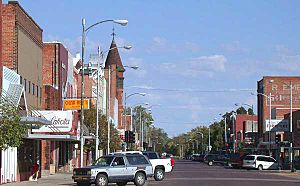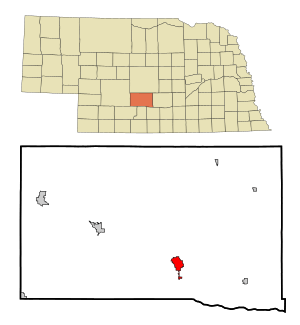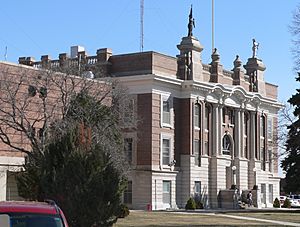Lexington, Nebraska facts for kids
Quick facts for kids
Lexington, Nebraska
|
|
|---|---|

Downtown Lexington, looking north (2004)
|
|

Location of Lexington within Nebraska and Dawson County
|
|
| Country | United States |
| State | Nebraska |
| County | Dawson |
| Area | |
| • Total | 5.10 sq mi (13.20 km2) |
| • Land | 5.07 sq mi (13.12 km2) |
| • Water | 0.03 sq mi (0.08 km2) |
| Elevation | 2,392 ft (729 m) |
| Population
(2020)
|
|
| • Total | 10,348 |
| • Density | 2,042.23/sq mi (788.53/km2) |
| Time zone | UTC−6 (Central (CST)) |
| • Summer (DST) | UTC−5 (CDT) |
| ZIP code |
68850
|
| Area code(s) | 308 |
| FIPS code | 31-26910 |
| GNIS feature ID | 2395698 |
Lexington is a city in Dawson County, Nebraska, in the United States. In 2020, about 10,348 people lived there. This makes it the 16th largest city in Nebraska. Lexington is also the county seat, which means it's where the main government offices for Dawson County are.
The city is located in southern Nebraska, right by the Platte River. It's also on U.S. Route 30 and the Union Pacific Railroad. Long ago, in the 1860s, Lexington was a stop for the Pony Express, which was a famous mail delivery service using horses.
Contents
History of Lexington
Lexington started as a place where traders could buy and sell goods in 1860. This trading post was later destroyed. In 1864, a fort called Fort Plum Creek was built nearby. The city of Lexington was officially founded in 1871. It was first named Plum Creek.
Plum Creek Railroad Attack
About 3.5 miles west of Lexington, there's a special marker. It shows the spot where a group of Cheyenne people attacked a Union Pacific train. This happened on August 7, 1867, while the first transcontinental railroad was being built. The train cars were broken into and burned. Sadly, three railroad workers were killed during the attack.
Geography and Climate
Lexington covers a total area of about 4.51 square miles (11.68 square kilometers). Most of this area is land, with only a small part being water.
Lexington's Climate
Lexington has a type of climate called a "hot-summer humid continental climate." This means it has warm, humid summers and cold winters. The hottest temperature ever recorded in Lexington was 114°F (46°C) in July 1954. The coldest temperature was -27°F (-33°C) in December 1983.
| Climate data for Canaday Steam Plant, Nebraska, 1991–2020 normals, extremes 1950–present | |||||||||||||
|---|---|---|---|---|---|---|---|---|---|---|---|---|---|
| Month | Jan | Feb | Mar | Apr | May | Jun | Jul | Aug | Sep | Oct | Nov | Dec | Year |
| Record high °F (°C) | 75 (24) |
79 (26) |
90 (32) |
93 (34) |
101 (38) |
110 (43) |
114 (46) |
106 (41) |
103 (39) |
95 (35) |
84 (29) |
77 (25) |
114 (46) |
| Mean maximum °F (°C) | 61.8 (16.6) |
66.2 (19.0) |
77.8 (25.4) |
84.9 (29.4) |
90.8 (32.7) |
96.0 (35.6) |
97.8 (36.6) |
96.0 (35.6) |
93.0 (33.9) |
87.1 (30.6) |
74.3 (23.5) |
62.9 (17.2) |
99.5 (37.5) |
| Mean daily maximum °F (°C) | 38.0 (3.3) |
41.3 (5.2) |
52.5 (11.4) |
61.7 (16.5) |
71.7 (22.1) |
82.1 (27.8) |
86.4 (30.2) |
84.3 (29.1) |
78.0 (25.6) |
65.1 (18.4) |
51.3 (10.7) |
39.8 (4.3) |
62.7 (17.1) |
| Daily mean °F (°C) | 26.6 (−3.0) |
29.6 (−1.3) |
39.7 (4.3) |
49.2 (9.6) |
60.0 (15.6) |
70.6 (21.4) |
75.2 (24.0) |
73.0 (22.8) |
65.0 (18.3) |
51.7 (10.9) |
38.9 (3.8) |
28.7 (−1.8) |
50.7 (10.4) |
| Mean daily minimum °F (°C) | 15.2 (−9.3) |
17.8 (−7.9) |
27.0 (−2.8) |
36.7 (2.6) |
48.3 (9.1) |
59.2 (15.1) |
64.1 (17.8) |
61.7 (16.5) |
52.1 (11.2) |
38.3 (3.5) |
26.4 (−3.1) |
17.6 (−8.0) |
38.7 (3.7) |
| Mean minimum °F (°C) | −5.9 (−21.1) |
−1.5 (−18.6) |
8.0 (−13.3) |
21.9 (−5.6) |
33.8 (1.0) |
46.8 (8.2) |
53.6 (12.0) |
50.7 (10.4) |
36.8 (2.7) |
21.8 (−5.7) |
9.0 (−12.8) |
−2.2 (−19.0) |
−11.1 (−23.9) |
| Record low °F (°C) | −22 (−30) |
−17 (−27) |
−17 (−27) |
9 (−13) |
23 (−5) |
36 (2) |
45 (7) |
42 (6) |
24 (−4) |
5 (−15) |
−12 (−24) |
−27 (−33) |
−27 (−33) |
| Average precipitation inches (mm) | 0.44 (11) |
0.61 (15) |
1.17 (30) |
2.41 (61) |
3.95 (100) |
3.67 (93) |
3.80 (97) |
3.10 (79) |
1.82 (46) |
1.89 (48) |
0.81 (21) |
0.59 (15) |
24.26 (616) |
| Average snowfall inches (cm) | 5.9 (15) |
4.9 (12) |
2.3 (5.8) |
1.0 (2.5) |
0.1 (0.25) |
0.0 (0.0) |
0.0 (0.0) |
0.0 (0.0) |
0.0 (0.0) |
0.6 (1.5) |
1.9 (4.8) |
3.3 (8.4) |
20.0 (51) |
| Average precipitation days (≥ 0.01 in) | 3.2 | 5 | 6.2 | 9.3 | 11.4 | 9.8 | 9.6 | 8.6 | 6.2 | 6.9 | 3.2 | 4.1 | 83.5 |
| Average snowy days (≥ 0.1 in) | 2.1 | 2.5 | 1.2 | 0.4 | 0.0 | 0.0 | 0.0 | 0.0 | 0.0 | 0.3 | 0.8 | 1.6 | 8.9 |
| Source 1: NOAA | |||||||||||||
| Source 2: National Weather Service | |||||||||||||
People of Lexington
| Historical population | |||
|---|---|---|---|
| Census | Pop. | %± | |
| 1890 | 1,392 | — | |
| 1900 | 1,343 | −3.5% | |
| 1910 | 2,059 | 53.3% | |
| 1920 | 2,327 | 13.0% | |
| 1930 | 2,962 | 27.3% | |
| 1940 | 3,688 | 24.5% | |
| 1950 | 5,068 | 37.4% | |
| 1960 | 5,572 | 9.9% | |
| 1970 | 5,654 | 1.5% | |
| 1980 | 7,040 | 24.5% | |
| 1990 | 6,601 | −6.2% | |
| 2000 | 10,011 | 51.7% | |
| 2010 | 10,230 | 2.2% | |
| 2020 | 10,348 | 1.2% | |
| U.S. Decennial Census | |||
Lexington is the main city in the Lexington Micropolitan Statistical Area. This area includes Dawson and Gosper counties, meaning they are connected by jobs and daily life.
2020 Census Information
In 2020, the 2020 United States census counted 10,348 people living in Lexington. There were 3,531 households (groups of people living together) and 2,609 families.
The population of Lexington is very diverse. About 33% of the people were white, and about 10% were black or African-American. There were also Native American, Asian, and Pacific Islander residents. A large part of the population, about 60%, identified as Hispanic or Latino.
Many households (43.3%) had children under 18. The average household had about 2.8 people. The average age of people in Lexington was 31.2 years old.
Lexington's Economy
In 1990, a big company called Iowa Beef Packers built a large meat packing plant in Lexington. This plant provides many jobs, with over 2,700 employees. In 2001, the plant was sold to another company called Tyson.
Arts and Culture
Lexington has some interesting places to visit:
- The Heartland Museum of Military Vehicles is located near I-80. It has a collection of military vehicles.
- The Dawson County Historical Society is a museum. It displays art made by local people and old items like cars, guns, and household objects that belonged to people from the area.
Many different religions are practiced in Lexington. In 2020, studies showed that over 6,000 people followed Protestant faiths, and over 5,000 people were Catholic.
Media and News
Radio Stations
Lexington is home to radio stations KRVN (AM) and KRVN-FM. These stations are owned by the Nebraska Rural Radio Association. This radio network was started in 1948 by a group of farmers and ranchers.
Local Newspaper
The city has a newspaper called the Lexington Clipper-Herald. It comes out twice a week.
Sports in Lexington
From 1956 to 1958, Lexington had its own minor league baseball team called the Lexington Red Sox. They played at the Dawson County Fairgrounds. The team was connected to the Boston Red Sox and was part of the Nebraska State League. In 1956, the Lexington Red Sox even won the Nebraska State League Championship!
Getting Around Lexington
Highways
Two major U.S. Highways serve Lexington. U.S. Route 30 runs east to west through the middle of town. U.S. Route 283 ends at Highway 30 near downtown. It connects Lexington to Interstate 80, which is about 3 miles south, and to other places in Kansas, Oklahoma, and Texas. Nebraska Highway 21 is a state highway that connects north to Broken Bow and southwest to Eustis.
Bus Service
You can travel to and from Lexington by bus. Services are provided by Burlington Trailways and Express Arrow.
Train Service
While the Union Pacific Overland Route train tracks go through Lexington, there is no passenger train service for people to ride. However, freight trains use the tracks to carry goods for local businesses like grain elevators, ethanol plants, and meat packing plants.
Airport
About two miles northwest of town, there is a general aviation airport called Jim Kelly Field. It is operated by the Lexington Airport Authority.
Famous People from Lexington
- Bill Barrett - A U.S. Congressman
- Aage Brix - Competed in soccer at the 1924 Summer Olympics
- Yoskar Galván-Mercado - A soccer player
- Monte Kiffin - A football coach
- Donald Roe Ross - A United States federal court judge and former mayor of Lexington
- Wee Willie Smith - A football player
- Mick Tingelhoff - A member of the Pro Football Hall of Fame
- John Wightman - A lawyer, Nebraska state legislator, and former mayor of Lexington
See also
 In Spanish: Lexington (Nebraska) para niños
In Spanish: Lexington (Nebraska) para niños


